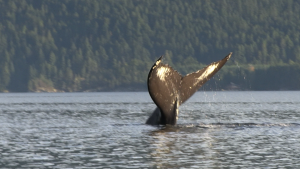Not much going on in whale world on the water for us these days. I heard reports of 4 or 5 humpbacks hanging out between Vancouver Island and Texada Island but we’ve been quite busy working.
Last month was about books to curl up and hibernate with during the dark days of winter.This month it’s time for cultural celebrations. And what better way to celebrate than by watching films about whales and interspecies communication?
Youtube is full of close encounters between humans and cetaceans, which I love. The excitement of the humans is in their voices. Even adult voices become squeaky as they leap up 2 octaves when confronted by the awesome presence of a 30 tonne whale approaching their boat. It’s a palpable primal reaction.
But there is little to fear. SLOW DOWN, don’t crowd, make sure you know where they are and they know where you are. It’s best if they can hear you so a slow or idling engine is helpful. If they approach you? it is an experience you will never forget and a story you will retell hundreds of times. Maybe you’ll even make a video!
Back to the many wonderful films about whales:
Of course any of the BBC series like “The Blue Planet”, “Planet Earth”, “Life of Mammals”, “Nature’s Great Events” offer state of the art production values and thrilling footage. The “making of” shorts they made of how they got the footage are fascinating too, especially for budding filmmakers.
National Geographic has become quite sensationalist in their approach to nature films since being bought out by Rupert Murdoch but this is a good one .
“Ocean Voyager” Whale Documentary – The Biggest Sea Creatures || National Geographic 2015
Story of a humpback mother and calf. The video repeats at 51:16
https://youtu.be/DWv8JRRl1s8
“The Birthplace of the Giants” in Northwestern Australia – Nat Geo 2015
https://youtu.be/7Q6rKN4Bc6U
Some other smaller productions companies produce great ocean nature films too
Ocean Stories 3 – “Dolphins and Whales” NONA NATUREDOCX and SEALIFE PRODUCTIONS 2011
“The Giants of Rurutu” Humpback Whales of Tahiti: SOUND & VISION/CINEMARINE 2011
The French Godfather of all ocean nature documentaries – Jacques Cousteau made hundreds of films. Find them in Wikipedia and Search for them in Youtube.
The Undersea World of Jacques Cousteau – “Whales” rerecorded 1991
https://youtu.be/DlHDK-aq9vM
and “The Singing Whale” about Humpback whales rerecorded 1991
https://youtu.be/e7ZKdZaViFg
The English Godfather of nature films, David Attenborough is still making features for the BBC. Find his filmography on Wikipedia and Search the series “The Blue Planet”, “Planet Earth”, “Life of Mammals”, “Nature’s Great Events” among others on Youtube
Planet Earth about the Oceans
https://www.youtube.com/watch?v=BGdyezNZt20
The Life series about mammals includes cetaceans
https://www.youtube.com/watch?v=dv2oobRVeTk
Nature’s Great Events Series: Everyone feeds on Herring in the Pacific Ocean
https://youtu.be/QSiTumuzfeQ
and Feast of Sardines off the coast of southern Africa
https://youtu.be/UQGvhn1w65Y
Civil war in Sri Lanka protected a recovering population of Blue whales
https://www.youtube.com/watch?v=WrWvkZjgrSk
Planet Ocean [UK]- by Yann Arthus-Bertrand & Michael Pitiot
Habitat of the Orca Killer Whales & Sea Creatures – Feodor Pitcairn Productions Ltd. 2000
https://youtu.be/rH5zO-EL5Fg
Intelligence and Communication in non-human species that may surprise you
https://youtu.be/Q-4w5xYLwiU?t=4s
And finally, humans who can communicate with other species:
“The Animal Communicator” with Anna Breytenbach and Jon Young by FOSTER BROTHERS FILM PRODUCTIONS for NHU AFRICA
https://youtu.be/S5vOgJAa6To
And how it might be possible
International Film Festivals
where you can find amazing nature films that don’t get Hollywood or network distribution.
Halifax International Oceans Film Festival
Cuban Ocean Environmental Film Fest
Asia Ocean Film Festival (Hong Kong)



 Terry, Jamie and I are perched together on rocks as far out as we can get at low tide waiting for the whales to come around to our side of the inlet. Jamie, who knows their routine, is sure they will make their usual circle and cruise by our campsite. It is dusk already. We can see 2 or 3 whales out in the middle of the inlet. Some of the resident sea lions seem to be playing around them but the light is fading.
Terry, Jamie and I are perched together on rocks as far out as we can get at low tide waiting for the whales to come around to our side of the inlet. Jamie, who knows their routine, is sure they will make their usual circle and cruise by our campsite. It is dusk already. We can see 2 or 3 whales out in the middle of the inlet. Some of the resident sea lions seem to be playing around them but the light is fading.
 Being positioned at a good angle while close enough to capture detail is a challenge. However, if we can identify our whales, we might be able to find them again at their southern migration points in Mexico, Hawaii or even Japan.
Being positioned at a good angle while close enough to capture detail is a challenge. However, if we can identify our whales, we might be able to find them again at their southern migration points in Mexico, Hawaii or even Japan. 